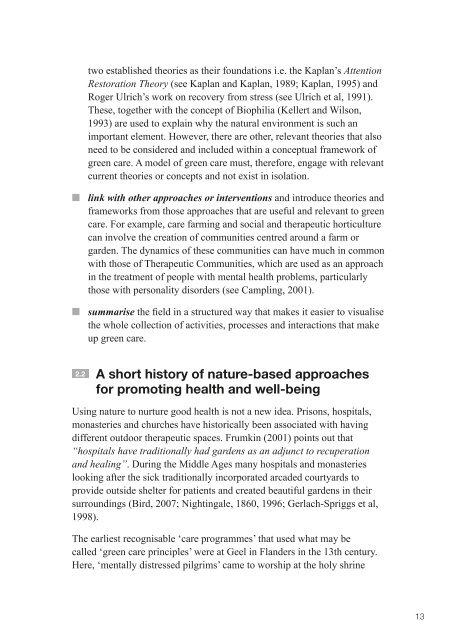Green Care: A Conceptual Framework - Frisk i naturen
Green Care: A Conceptual Framework - Frisk i naturen
Green Care: A Conceptual Framework - Frisk i naturen
Create successful ePaper yourself
Turn your PDF publications into a flip-book with our unique Google optimized e-Paper software.
two established theories as their foundations i.e. the Kaplan’s Attention<br />
Restoration Theory (see Kaplan and Kaplan, 1989; Kaplan, 1995) and<br />
Roger Ulrich’s work on recovery from stress (see Ulrich et al, 1991).<br />
These, together with the concept of Biophilia (Kellert and Wilson,<br />
1993) are used to explain why the natural environment is such an<br />
important element. However, there are other, relevant theories that also<br />
need to be considered and included within a conceptual framework of<br />
green care. A model of green care must, therefore, engage with relevant<br />
current theories or concepts and not exist in isolation.<br />
■ ■ link with other approaches or interventions and introduce theories and<br />
frameworks from those approaches that are useful and relevant to green<br />
care. For example, care farming and social and therapeutic horticulture<br />
can involve the creation of communities centred around a farm or<br />
garden. The dynamics of these communities can have much in common<br />
with those of Therapeutic Communities, which are used as an approach<br />
in the treatment of people with mental health problems, particularly<br />
those with personality disorders (see Campling, 2001).<br />
■■ summarise the field in a structured way that makes it easier to visualise<br />
the whole collection of activities, processes and interactions that make<br />
up green care.<br />
2.2 A short history of nature-based approaches<br />
for promoting health and well-being<br />
Using nature to nurture good health is not a new idea. Prisons, hospitals,<br />
monasteries and churches have historically been associated with having<br />
different outdoor therapeutic spaces. Frumkin (2001) points out that<br />
“hospitals have traditionally had gardens as an adjunct to recuperation<br />
and healing”. During the Middle Ages many hospitals and monasteries<br />
looking after the sick traditionally incorporated arcaded courtyards to<br />
provide outside shelter for patients and created beautiful gardens in their<br />
surroundings (Bird, 2007; Nightingale, 1860, 1996; Gerlach-Spriggs et al,<br />
1998).<br />
The earliest recognisable ‘care programmes’ that used what may be<br />
called ‘green care principles’ were at Geel in Flanders in the 13th century.<br />
Here, ‘mentally distressed pilgrims’ came to worship at the holy shrine<br />
13















